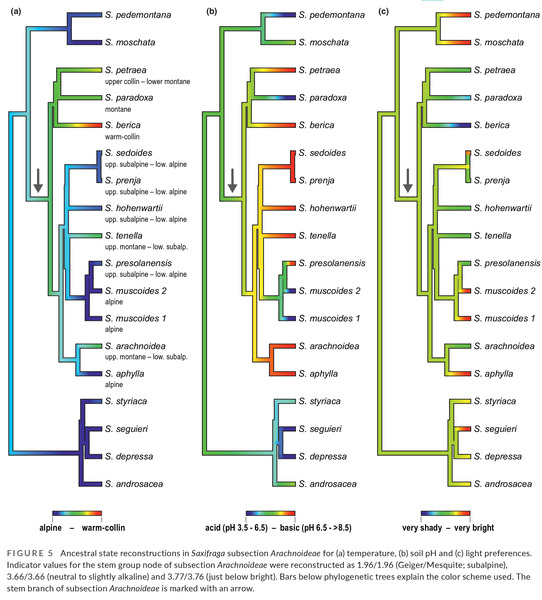Winter Semester 2023-2024
A joint seminar of the section Systematics, Biodiversity & Evolution of Plants, the Botanische Staatssammlung München and the Botanical Garden München-Nymphenburg
Program
11 October 2023 at 5:00pm: Dr. Farida Minibayeva, Kazan Institute of Biochemistry and Biophysics, Russian Academy of Sciences, Kazan, Russia.
Enigmatic melanins: from microorganisms to electronics
 Melanins (from the Greek μέλας, “black”) are structurally complex dark pigments found in all biological kingdoms. Despite their natural versatility, these are one of the most enigmatic biopolymers in the biosphere. Natural melanins are heterogeneous polymers formed by the oxidation of phenolic/indole precursors and subsequent polymerization of intermediate phenols and quinones. These pigments have a variety of functions such as free radical quenching, protection against light stress, energy transfer, thermoregulation, metal chelation, camouflage, immune response, and virulence. The microstructure of melanins has been studied in some detail for the pathogenic fungi and human melanosomes; information on the structure and physicochemical properties of melanins in photosynthetic organisms is extremely limited. Of particular interest are the properties, morphology and functions of melanins in extremophilic organisms, including lichens. Lichens are symbiotic organisms formed as a result of a mutually beneficial alliance of a fungus (mycobiont) and algae/cyanobacteria (photobiont). For lichens, the formation of a melanin layer on the surface of the thallus in response to UV exposure is one of the key mechanisms of their high resistance not only to excess light, but also to xenobiotics and dehydration. The unique properties of melanin make this natural polymer a promising subject for fundamental and applied research, in particular, for the development of so-called “green electronics”, and other applications in medicine, biotechnology and remediation.
Melanins (from the Greek μέλας, “black”) are structurally complex dark pigments found in all biological kingdoms. Despite their natural versatility, these are one of the most enigmatic biopolymers in the biosphere. Natural melanins are heterogeneous polymers formed by the oxidation of phenolic/indole precursors and subsequent polymerization of intermediate phenols and quinones. These pigments have a variety of functions such as free radical quenching, protection against light stress, energy transfer, thermoregulation, metal chelation, camouflage, immune response, and virulence. The microstructure of melanins has been studied in some detail for the pathogenic fungi and human melanosomes; information on the structure and physicochemical properties of melanins in photosynthetic organisms is extremely limited. Of particular interest are the properties, morphology and functions of melanins in extremophilic organisms, including lichens. Lichens are symbiotic organisms formed as a result of a mutually beneficial alliance of a fungus (mycobiont) and algae/cyanobacteria (photobiont). For lichens, the formation of a melanin layer on the surface of the thallus in response to UV exposure is one of the key mechanisms of their high resistance not only to excess light, but also to xenobiotics and dehydration. The unique properties of melanin make this natural polymer a promising subject for fundamental and applied research, in particular, for the development of so-called “green electronics”, and other applications in medicine, biotechnology and remediation.
Host: Prof. Dr. Silke Werth
19 October 2023 (Thursday): Prof. Dr. J.F. Niek Scheepens, Faculty of Biological Sciences, Goethe University Frankfurt, Germany.
Resurrecting plants for climate change research
Climate change may cause rapid evolutionary changes in plant populations. The resurrection approach, in which individuals raised from ancestral propagules are compared with individuals raised from descendants of the same population, is a powerful and direct method to reveal evolutionary changes over time and can therefore be used to investigate how recent environmental dynamics affect rapid evolution. I will show that conventional seed banks are a valuable source of ancestral propagules for multispecies resurrection studies. Furthermore, I will provide evidence from resurrection studies that rapid evolutionary changes took place across plant taxa in Europe, possibly as adaptive response to climate-change related environmental changes. Finally, I will show how resurrection ecology can adopt classical methods from experimental plant ecology and modern molecular techniques to increase our understanding of rapid evolutionary processes.
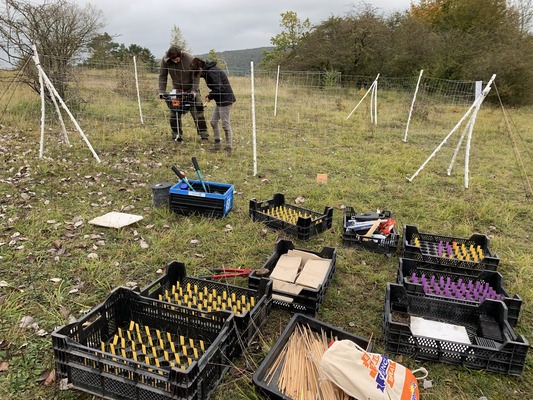
Host: Prof. Dr. Gudrun Kadereit
 25 October 2023: Dr. Ramona-Elena Irimia, Plant Evolutionary Ecology, Institute of Evolution & Ecology, Universität Tübingen, Germany.
25 October 2023: Dr. Ramona-Elena Irimia, Plant Evolutionary Ecology, Institute of Evolution & Ecology, Universität Tübingen, Germany.
Using herbarium genomics to understand spatio-temporal dynamics and mechanisms of plant response to changing environments
Time series studies across large spatial scales are greatly needed to document ecological and evolutionary processes behind successful colonization events. Herbarium records can act as a “time-machine” and offer a unique opportunity to model past processes and gain insights into the species history and responses to environmental and anthropogenic perturbations. Species of the genus Reynoutria (Japanese knotweed, Polygonaceae) are among the world’s worst invasive weeds and their extensive success provides an excellent system to investigate species expansion and adaptation to heterogeneous environments. Originally from South-East Asia, they were introduced globally ca. 180 ago as garden ornamentals, and later escaped into the wild and became highly invasive in large parts of Europe and North America. Using the Japanese knotweed example, I will discuss the powerful approach of using museum specimens and historical DNA in evolutionary and population genomics studies, to infer how species respond to environmental challenges.
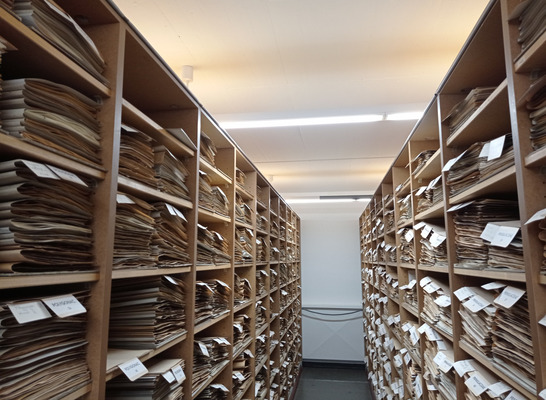
Contact: ramona-elena.irimia@uni-tuebingen.de
Host: Prof. Dr. Marc Gottschling
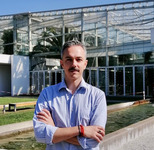 08 November 2023: Prof. Dr. Franceso Dal Grande, Dept. of Biology, University of Padua, Italy.
08 November 2023: Prof. Dr. Franceso Dal Grande, Dept. of Biology, University of Padua, Italy.
Dryland biobanking: exploring the hidden green life of deserts and the origin of lichenization
Drylands - areas with an aridity index below 0.65 - occupy more than 40% of Earth’s surface and are among the most sensitive ecosystems to climate change. Soil microbial communities are intricately linked to ecosystem functioning in drylands because they play important roles in carbon and nitrogen cycling, soil fertility and climate regulation. Unicellular green algae constitute a crucial component of these communities with key roles in primary production, food webs and nutrient cycling, soil formation, and modulation of soil texture and structure. Despite the importance of microalgae in the stability of these ecosystems, the phototrophic micro-algal flora represents a vastly understudied component of soil microbial communities. Limited knowledge of their diversity, of host- microbiome and within-microbiome interactions and of the adaptive traits important for survival in extreme environments translates into limited ability to monitor and eventually prevent biodiversity losses.
In my talk I will present the results of a recently concluded project that generated comprehensive baseline data on diversity, distribution patterns, and community composition of terrestrial microalgae in global drylands (80 sites worldwide, 13 countries). The study highlights the presence of hundreds of undescribed taxa from all major groups of green algae. The living algal collection obtained from these soils constitutes an ideal starting point to investigate the genomic and functional traits responsible for the adaptation to extreme environments in these organisms and other evolutionary novelties, such as the ability to form lichen symbioses.
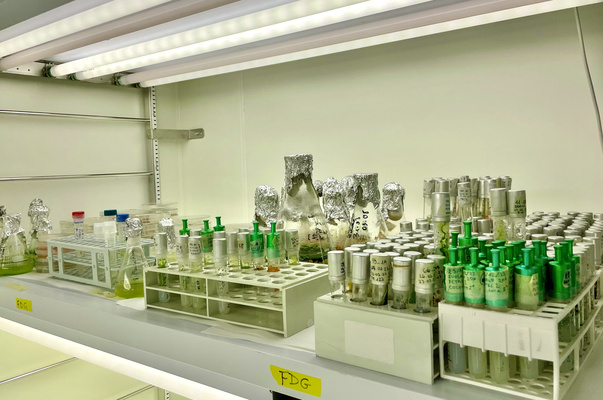
Host: PD. Dr. Andreas Beck
15 November 2023: Dr. Nora Walden, COS, Universität Heidelberg, Germany.
Resolving the evolutionary history of Arabideae using paralogs
 The Arabideae represent the largest Brassicaceae tribe with ~550 species in 18 genera, among them eponymous Arabis and the large genus Draba with over 400 species. Polyploidy is prevalent in the tribe, with ploidy levels up to hexadecaploid; and hybridization is hypothesized to be common. Previous phylogenetic studies have identified larger clades consistently, but failed to provide resolution at the species level, in part likely due to the presence of paralogs remaining from past whole-genome duplications (WGDs) and hybridizations.
The Arabideae represent the largest Brassicaceae tribe with ~550 species in 18 genera, among them eponymous Arabis and the large genus Draba with over 400 species. Polyploidy is prevalent in the tribe, with ploidy levels up to hexadecaploid; and hybridization is hypothesized to be common. Previous phylogenetic studies have identified larger clades consistently, but failed to provide resolution at the species level, in part likely due to the presence of paralogs remaining from past whole-genome duplications (WGDs) and hybridizations.
We have developed a concept and workflow to infer polyploidization status from target enrichment data and reconstruct the evolutionary history of the taxa of interest using evolutionary placement of paralogs into a diploid reference tree. This method allows us to use information from paralogs despite multiple rounds of WGD and hybridization.
Our results provide a solid backbone phylogeny for the Arabideae and pinpoint the ancestral lineages involved in past hybridizations. Within Draba, we found strong evidence that one of three main evolutionary lineages originated from hybridization between the other two lineages, with subsequent hybridizations giving rise to further subclades. In total we identified 68% of our samples as ancient polyploids and clustered them in over 40 clades with different patterns of paralog placement, suggesting independent or additional WGDs and hybridization events. Our study highlights the need for novel approaches to phylogenomics in clades with complex evolutionary histories.
Host: Dr. Elizabeth Joyce
22 November 2023: Prof. Dr. Joachim W. Kadereit (retired), Systematics, Biodiversity and Evolution of Plants, LMU Munich, Germany.
Plant evolution in the European Alps - The origin of serpentine-tolerant Minuartia and shade-tolerant Saxifraga and a note on the uneven distribution of endemics
In the last c. 2.5 myrs, the Quaternary, the European Alps experienced 50+ glacial/interglacial cycles. This resulted not only in major shifts of geographical distribution but also in evolutionary change and the origin of new lineages. I will look at the origin of unusual ecologies. In case of Minuartia laricifolia, the serpentine endemic ssp. ophiolitica is most closely related to the more widespread calcifuge ssp. laricifolia. Saxifraga sect. Saxifraga subsect. Arachnoideae contains species from open high-elevation habitats as well as species from low-elevation shady hollows under overhanging rocks such as S. berica and S. arachnoidea. In both cases I will hypothesize that the ecologically divergent taxa originated in a two-step process. In glacials, populations became geographically isolated in refugia along the southern edge of the Alps. These populations persisted in their refugial areas upon interglacial/Holocene climate warming and evaded more competitive warm-stage vegetation by adapting to their unusual habitats.
I will also briefly consider why most endemics of the Alps, similar to M. laricifolia ssp. ophiolitica and Saxifraga arachnoidea and S. berica, are found along their southern edges whereas essentially no endemics are found in the north.
Figure 5 (Gerschwitz-Eidt et al. 2023).
29 November 2023: Prof. Dr. Rainer W. Bussmann, Staatliches Museum für Naturkunde Karlsruhe, Germany and Ilia State University, Institute of Botany and Bakuriani Alpine Botanical Garden, Department of Ethnobotany, Botanical Str, 0105 Tbilisi, Georgia.
Quo vadis Botany?
 Botany, including ethnobotany, has changed greatly over the last decades. On the scientific side, research has moved from simple species inventories, to detailed quantitative studies, genomics, and the elucidation of active compounds. Both developments are highly important but have also led to some disadvantages. On the one hand, the focus on "modern" studies has led to a decline of knowledge on, and publications of classic taxonomic studies, and field studies, and often neglect of classic herbaria. On the other hand, the very widespread use of statistical indices both in ecology and e.g., ethnobotanical field research has led to a virtual inflation of index use, with the application of often only one index, and wrongly extrapolating on plant importance from this, or applying multiple indices, but coming to wrong conclusions, especially with regard to conservation implications or the "usefulness of plants for further drug development."
Botany, including ethnobotany, has changed greatly over the last decades. On the scientific side, research has moved from simple species inventories, to detailed quantitative studies, genomics, and the elucidation of active compounds. Both developments are highly important but have also led to some disadvantages. On the one hand, the focus on "modern" studies has led to a decline of knowledge on, and publications of classic taxonomic studies, and field studies, and often neglect of classic herbaria. On the other hand, the very widespread use of statistical indices both in ecology and e.g., ethnobotanical field research has led to a virtual inflation of index use, with the application of often only one index, and wrongly extrapolating on plant importance from this, or applying multiple indices, but coming to wrong conclusions, especially with regard to conservation implications or the "usefulness of plants for further drug development."
In this context the recent outbreak of coronavirus disease (COVID-19) is an interesting example. In botanical research COVID-19 might be an incentive to better implement the Nagoya Protocol on Access and Benefit Sharing and change the role of local participants and give them the role they deserve, - to not only be participants, but investigators, and co-authors. Rather than sending (mostly) western students and researchers around the globe, COVID-19 might finally force the botanical community to focus on wider training of local researchers, so that they can conduct interviews in their own communities, and then to fully participate in data analysis and publication.
In this talk, we assess the contribution of ethnobotanical studies in the management of diseases and food security, and the changes in research under the Convention on Biological Diversity and the attached Nagoya Protocol, and their effect on the possibilities for future studies, outlining in which directions Botany might develop in the 21 century.
Contact: rainer.bussmann@smnk.de; rainer.bussmann@iliauni.edu.ge
Host: Dr. Hans-Joachim Esser
06 December 2023 (Postponed until further notice): Prof. Dr. Olivier Hardy, Université libre de Bruxelles, Belgium.
Biogeographic questions using tree genetic diversity in Africa
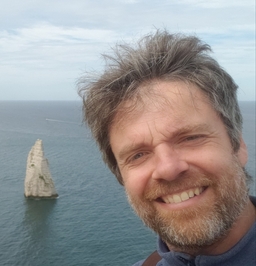
Genetic and genomic information is increasingly used for fundamental and applied research in all areas touching biodiversity, a trend facilitated by the fast development of DNA sequencing technologies. I will illustrate how genetic data on African forest trees have provided important insights to understand their taxonomy, ecology and evolution, and are also useful for forest management. (i) Population genetics approaches have clarified species delimitation and taxonomy in complex genera, highlighting the existence of many cryptic species, so that the richness in tree species in tropical Africa is probably much larger than indicated by current taxonomy and floristic lists. (ii) DNA sequences conserve traces of historical demographic events that have shaped the current genetic diversity of the populations (phylogeography). Past population fragmentation is a common pattern observed in most tree species that can reflect past changes in the forest cover. Using fully sequenced plastomes, it is also possible to infer past colonization and range expansion processes on a timescale using a molecular clock. However, in some genera plastomes are easily transferred between species, a phenomenon which could lead to a form of reticulate evolution in 'syngameons'. (iii) Genetic markers are powerful to infer reproduction processes, such as the mating system, pollen and seed dispersal distances, or the determinants of reproductive success. Such information is particularly useful for the sustainable management of timber species to define practical measures ensuring that natural populations retain a good reproductive potential after logging operations.
Host: Prof. Dr. Marie Claire Veranso-Libalah
13 December 2023: Prof. Dr. Imke Schmitt, Senckenberg Biodiversity and Climate Research Centre, Head of Research Group 'Molecular Evolutionary Biology', Goethe-Universität Frankfurt am Main, Germany.
The role of climate in structuring lichen holobionts
The lichen holobiont can be viewed as a micro-ecosystem consisting of a primary fungal partner, primary photosynthetic symbionts (green algae or cyanobacteria), other fungi and algae, and a bacterial microbiome. Like other ecosystems, this symbiotic consortium responds to environmental variables. Here we use elevation gradients to investigate the role of climate in shaping geographic distribution patterns of individual components of the lichen holobiont. We study altitudinal distributions of green algal strains, bacterial communities, and intraspecies genome-wide differentiation of fungal partners. There is evidence for abrupt changes in lichen holobiont composition along elevation, and for climatic niche partitioning of green algal strains. We observe physiological and transcriptional differences among lichen individuals with different partner compositions, as well as genome-wide differentiation of fungi and algae related to the environment. We hypothesize that favoring different combinations of partners in different environments is a mechanism for niche specialization in lichen holobionts.
Host: Prof. Dr. Silke Werth
10 January 2024: Dr. Tim Böhnert, Nees-Institut für Biodiversität der Pflanzen, Universität Bonn, Germany.
Historical biogeography and evolution of desert plants
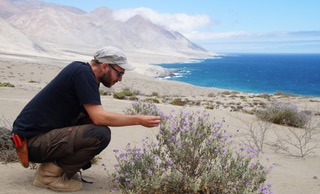 Contrary to the common perception of deserts as lifeless expanses and barren wastelands, many of these environments are veritable hotspots of biodiversity. In fact, certain deserts, including those in Central Asia, Australia, and the Atacama Desert in South America, are surprisingly rich in plant species. Yet desert regions are conspicuously underrepresented in macroecological and evolutionary research, even though they cover nearly one-third of the Earth's land surface. Due to their extreme climatic conditions, deserts are particularly vulnerable to climate change, which poses additional challenges and uncertainties for these ecosystems. Understanding the resilience of desert biodiversity in the face of such environmental changes is therefore crucial. Key challenges include understanding the interplay between the colonization history of plants, their adaptation to desert environments, and the age of these arid landscapes. In addition, there is a distinct lack of understanding of how patterns of plant diversity have evolved in deserts, and whether consistent patterns of traits emerge across different deserts. Post-Miocene climate history, particularly in arid environments, has emerged as a key factor in shaping species dispersal and diversification. For example, the Atacama Desert in northern Chile, one of the driest regions on Earth, is notable for its inferred Oligocene-Miocene age, as well as its unexpectedly high biodiversity and increased number of endemic species thriving under hyperarid conditions. We argue that the recent climatic history, marked by intervals of pluvial and arid phases, especially during the Pliocene-Pleistocene transition, played an important role in shaping the current desert flora. Here I will present work from several projects that focus mainly on South American desert ecosystems, as well as providing a global perspective on desert floras in general. These projects have included studies of plant evolution and biogeography, adaptations to arid conditions, and the effects of climate change on desert environments.
Contrary to the common perception of deserts as lifeless expanses and barren wastelands, many of these environments are veritable hotspots of biodiversity. In fact, certain deserts, including those in Central Asia, Australia, and the Atacama Desert in South America, are surprisingly rich in plant species. Yet desert regions are conspicuously underrepresented in macroecological and evolutionary research, even though they cover nearly one-third of the Earth's land surface. Due to their extreme climatic conditions, deserts are particularly vulnerable to climate change, which poses additional challenges and uncertainties for these ecosystems. Understanding the resilience of desert biodiversity in the face of such environmental changes is therefore crucial. Key challenges include understanding the interplay between the colonization history of plants, their adaptation to desert environments, and the age of these arid landscapes. In addition, there is a distinct lack of understanding of how patterns of plant diversity have evolved in deserts, and whether consistent patterns of traits emerge across different deserts. Post-Miocene climate history, particularly in arid environments, has emerged as a key factor in shaping species dispersal and diversification. For example, the Atacama Desert in northern Chile, one of the driest regions on Earth, is notable for its inferred Oligocene-Miocene age, as well as its unexpectedly high biodiversity and increased number of endemic species thriving under hyperarid conditions. We argue that the recent climatic history, marked by intervals of pluvial and arid phases, especially during the Pliocene-Pleistocene transition, played an important role in shaping the current desert flora. Here I will present work from several projects that focus mainly on South American desert ecosystems, as well as providing a global perspective on desert floras in general. These projects have included studies of plant evolution and biogeography, adaptations to arid conditions, and the effects of climate change on desert environments.
Host: Dr. Anže Žerdoner Čalasan
24 January 2024: Dr. Martha Paola Barajas Barbosa, Biodiversity Synthesis Group, German Centre for Integrative Biodiversity Research (iDiv) Leipzig, Germany.
Online seminar: Join Zoom meeting
Volcanic islands are great natural labs to address long-standing and future biodiversity questions
 The distinctive characteristics of volcanic islands, such as the emergence devoid of life and unique geographical isolation, make them ideal model systems for testing ecological and evolutionary hypotheses. A notable example is the Theory of Evolution (Darwin 1859), based on the Galapagos Islands (Ecuador). Volcanic islands also harbour unique diversity, as they are hotspots of endemism. However, the escalating impact of human activities, particularly human-driven biological invasions, poses a serious threat to the biodiversity of these remote environments. In this presentation, I will share insights of my research conducted in two iconic volcanic archipelagos—the Canary Islands (Spain) and the Hawaiian Islands (USA)—, where I try to unravel the interplay of ecology, biogeography, and macroevolutionary processes that shape the plant diversity within these systems.
The distinctive characteristics of volcanic islands, such as the emergence devoid of life and unique geographical isolation, make them ideal model systems for testing ecological and evolutionary hypotheses. A notable example is the Theory of Evolution (Darwin 1859), based on the Galapagos Islands (Ecuador). Volcanic islands also harbour unique diversity, as they are hotspots of endemism. However, the escalating impact of human activities, particularly human-driven biological invasions, poses a serious threat to the biodiversity of these remote environments. In this presentation, I will share insights of my research conducted in two iconic volcanic archipelagos—the Canary Islands (Spain) and the Hawaiian Islands (USA)—, where I try to unravel the interplay of ecology, biogeography, and macroevolutionary processes that shape the plant diversity within these systems.
Host: Dr. Diego F. Morales-Briones
31 January 2024: Prof. Dr. Simone Moser / Dr. Cornelia Karg, Universität Innsbruck, Austria.
Questioning the Detox Paradigm - Chlorophyll Degradation as Source of Bioactive Compounds
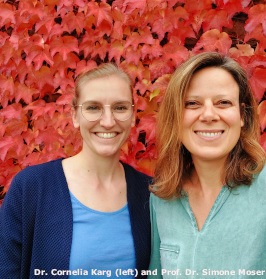 Chlorophyll degradation is one of the most visible signs of life on Earth and mostly associated with the fascinating change of colors we can observe every autumn. Nevertheless, the fate of the green plant pigment has remained a mystery for a long time, as has the biochemical pathway. Nowadays we know that chlorophyll breakdown leads to a family of natural products, the phyllobilins, which occur in rich structural variety. Despite their abundance and the fact that they are part of human nutrition, phyllobilins are surprisingly unexplored in regard to their bioactivities, mostly due to the fact that they have been regarded as ‘mere’ products of a detoxification pathway. Our recent work, however, points towards biological roles of phyllobilins in plants as well as in humans. In our studies, we found significant effects on cancer cells when testing different types of phyllobilins, i.e. inhibition of proliferation and induction of apoptosis. We further aim at understanding the mechanism by which phyllobilins kill cancer cells and how this mode of action can be exploited for cancer prevention or therapeutical applications.
Chlorophyll degradation is one of the most visible signs of life on Earth and mostly associated with the fascinating change of colors we can observe every autumn. Nevertheless, the fate of the green plant pigment has remained a mystery for a long time, as has the biochemical pathway. Nowadays we know that chlorophyll breakdown leads to a family of natural products, the phyllobilins, which occur in rich structural variety. Despite their abundance and the fact that they are part of human nutrition, phyllobilins are surprisingly unexplored in regard to their bioactivities, mostly due to the fact that they have been regarded as ‘mere’ products of a detoxification pathway. Our recent work, however, points towards biological roles of phyllobilins in plants as well as in humans. In our studies, we found significant effects on cancer cells when testing different types of phyllobilins, i.e. inhibition of proliferation and induction of apoptosis. We further aim at understanding the mechanism by which phyllobilins kill cancer cells and how this mode of action can be exploited for cancer prevention or therapeutical applications.
Yellowing of leaves during senescence the result of a detoxification process employed by plants to get rid of phototoxic chlorophyll - but what if the products accumulating at the end of this process, the phyllobilins, are more than just waste? This is the central question of my research endeavours, which will be outlined in this seminar.
Host: Dr. Andreas Gröger
07 February 2024: Dr. Nomar E. Waminal, Leibniz institute of plant genetics and crop plant research (IPK) Gatersleben, Germany.
Descending dysploidy and repeat expansion drive the evolution of Crocus series Verni
Nomar Espinosa Waminal, Frank R. Blattner, and Dörte Harpke
Spring crocuses, which comprise ten diploid and two polyploid species, as well as a polyploid complex, show diverse chromosome numbers (2n = 8, 10, 12, 14, 16, 18, 20, 22, 28), indicating dysploid karyotype changes. This high rate of dysploidy provides the opportunity to analyze mechanisms driving fast karyotype evolution in this genus. Here, we gather insights into dysploidy in Crocus ser. Verni by analyzing the genomic dynamics of repetitive elements. We characterized the types and abundances of repetitive genomic elements from each taxon and performed a comparative karyotype analysis in a phylogenomic context. Crocus longiflorus, which has 2n = 28 chromosomes, has the smallest genome size (2C = 3.2 pg), whereas taxa with fewer chromosomes have increased genome sizes. Repeat quantification, FISH analysis of six repeat families, and chromosome painting suggest a concerted action of descending dysploidy and a burst of transposable elements (Ty1/Copia and Ty3/Gypsy) as drivers to the reduction of chromosome number while increasing genome size in more recently evolved taxa. This work provides insights into dysploidy in ser. Verni and an opportunity to develop approaches to study other dysploid-rich clades in plants.
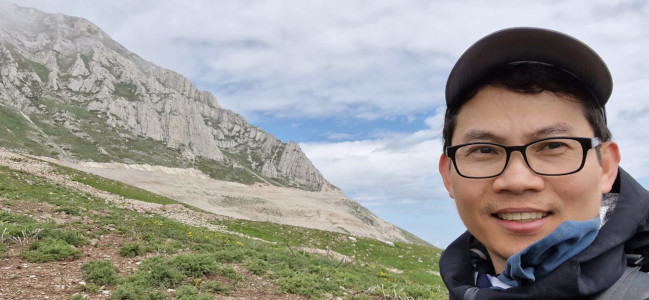
Host: Dr. Christian Siadjeu
________________________________________


